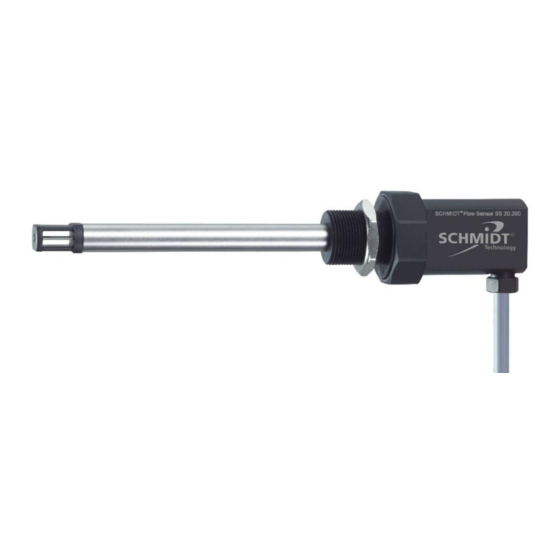Table of Contents
Advertisement
Quick Links
Advertisement
Table of Contents

Summary of Contents for Schmidt SS 20.260
- Page 1 ® SCHMIDT Flow Sensor SS 20.260 Instructions for Use...
-
Page 2: Table Of Contents
Startup ................... 14 Information concerning operation ..........15 Service information ................ 16 Technical data ................18 Declaration of conformity ............... 19 Imprint: Copyright 2020 SCHMIDT Technology GmbH All rights reserved Version 508981.02H Subject to modifications Instructions for Use – SCHMIDT ®... -
Page 3: Important Information
SCHMIDT Technology cannot give any warranty as to its suitability for certain purpose and cannot be held liable for accidental or sequen- tial damage in connection with the delivery, performance or use of this unit. -
Page 4: Application Range
3 Mounting instructions General information on handling The SS 20.260 is a precision instrument with high measuring sensitivity. In spite of the robust construction of the sensor tip soiling of the inner sen- sor elements can lead to distortion of measurement results (see also chap- ter 8). - Page 5 (such as edges, seams, bends etc.). It is also necessary to pay attention to the design of the run-out distance because disturbances also generate turbulences against the flow direction. Instructions for Use – SCHMIDT ® Flow sensor SS 20.260...
- Page 6 Alternatively, flow rectifiers could be used, e.g. honeycombs made of plastic or ceramics. Considers the flow profile and sensor obstruction. Instructions for Use – SCHMIDT ® Flow sensor SS 20.260 Page 6...
- Page 7 0.850 1.419 11.353 28.383 0.854 2.066 16.527 41.317 0.857 2.834 22.673 56.683 0.859 3.723 29.781 74.452 0.862 4.740 37.920 94.800 1000 1000 0.864 5.865 46.923 117.308 Table 2 Instructions for Use – SCHMIDT ® Flow sensor SS 20.260 Page 7...
- Page 8 SCHMIDT Technology provides a convenient calculation tool to compute flow velocity or volume flow in pipes (circular or rectangular) for all its sen- sor types and measuring ranges on its homepage: www.schmidt-sensors.com Mounting in a wall The housing has an external thread M18 x 1 (19 mm long) for direct mounting on or in the medium separating wall.
- Page 9 In case of a longer sensor probe push it partly into the pipe as re- quired. Always avoid bending of the probe tube during screwing. Instructions for Use – SCHMIDT ® Flow sensor SS 20.260 Page 9...
- Page 10 - Pipe (typ.), wall - Screwing into a welding stud 517 206 - Material: Brass PTFE, NBR Atmospheric pressure use! SW24 SW27 Table 3 Must be welded. Instructions for Use – SCHMIDT ® Flow sensor SS 20.260 Page 10...
-
Page 11: Electrical Connection
U Both signal outputs 22 mA (maximum measuring values), minimum operating voltage. It is recommended, to use AGND as measuring reference potential for voltage output. Instructions for Use – SCHMIDT ® Flow sensor SS 20.260 Page 11... -
Page 12: Signalization
Supply voltage beyond specification range or Medium temperature beyond specification range Sensor defective Table 5 LED off LED flashes (approx. 2 Hz): green LED on: green LED flashes (approx. 2 Hz): red Instructions for Use – SCHMIDT ® Flow sensor SS 20.260 Page 12... - Page 13 For a correct temperature measurement, the flow velocity on the sensor head must be > 2 m/s. An excessive temperature value is output if flow velocity is < 2 m/s. In accordance with NAMUR specification. Instructions for Use – SCHMIDT ® Flow sensor SS 20.260 Page 13...
-
Page 14: Startup
Figure 7 Representation for medium temperature 6 Startup ® Prior to switching on the SCHMIDT Flow sensor SS 20.260, the follow- ing checks have to be carried out: Immersion depth of the sensor probe and alignment of the housing. -
Page 15: Information Concerning Operation
Check mounting conditions Sensor head is not in optimal position Run-in/run-out distance is too short Strong fluctuations of pressure or Check operating parameters temperature Table 6 Instructions for Use – SCHMIDT ® Flow sensor SS 20.260 Page 15... -
Page 16: Service Information
Conventional cotton swabs are too big and therefore can break the chip. Instructions for Use – SCHMIDT ® Flow sensor SS 20.260 Page 16... - Page 17 Before putting it into operation again, wait until the sensor head is com- pletely dried. The drying process can be accelerated by gently blowing If this procedure does not help, the sensor must be sent to SCHMIDT Technology for cleaning or repair.
-
Page 18: Technical Data
50 / 100 / 200 / 350 / 500 mm Weight 200 g max. Table 7 Measuring ranges of 50 m/s and 60 m/s only for variant “2”. Under conditions of the reference. With cable end sleeves Instructions for Use – SCHMIDT ® Flow sensor SS 20.260 Page 18... -
Page 19: Declaration Of Conformity
10 Declaration of conformity Instructions for Use – SCHMIDT ® Flow sensor SS 20.260 Page 19... - Page 20 SCHMIDT Technology GmbH Feldbergstraße 1 78112 St. Georgen Germany Phone +49 (0)7724 / 899-0 +49 (0)7724 / 899-101 Email sensors@schmidttechnology.de www.schmidt-sensors.com Instructions for Use – SCHMIDT ® Flow sensor SS 20.260 Page 20...














Need help?
Do you have a question about the SS 20.260 and is the answer not in the manual?
Questions and answers